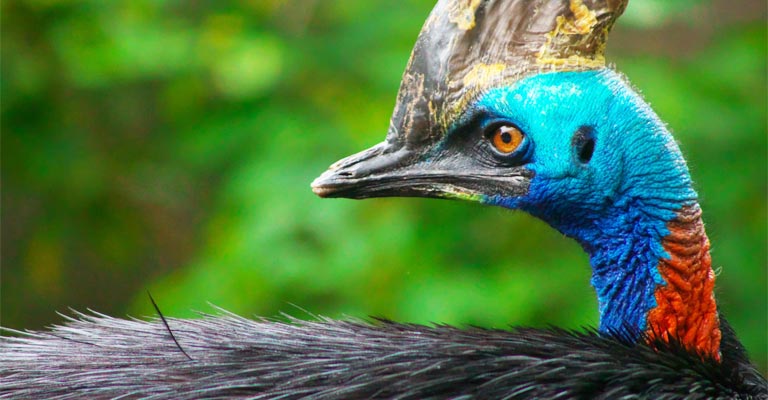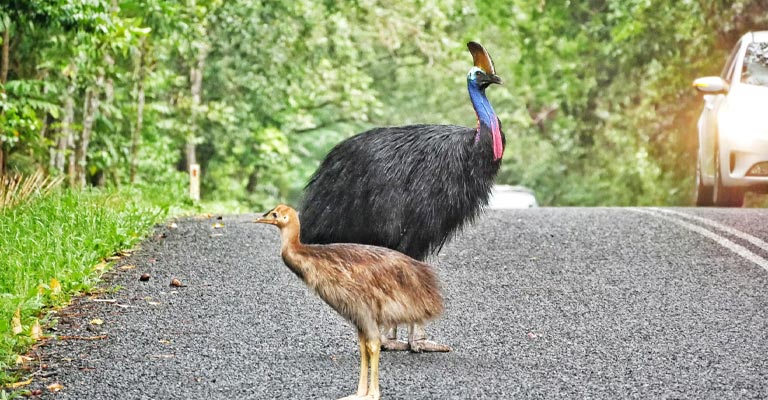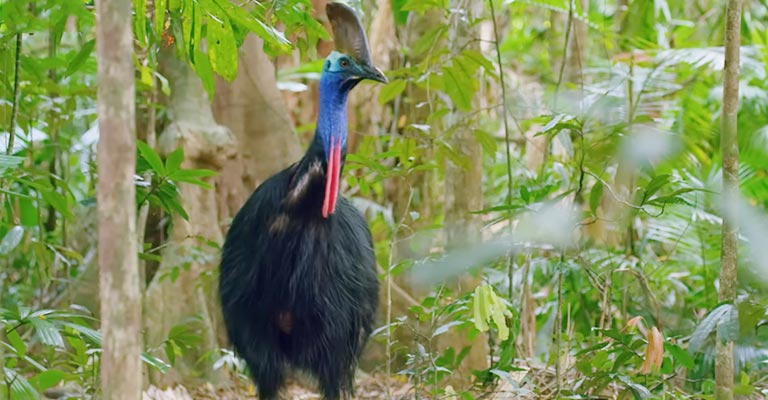The cassowary, an enigmatic and striking bird native to the tropical rainforests of northern Australia, New Guinea, and nearby islands, is renowned for its captivating beauty and remarkable danger.
Often regarded as one of the most dangerous birds on the planet, the cassowary stands as a testament to the coexistence of awe and peril in the natural world.
In this exploration, we delve into the intriguing facets of why is the cassowary so dangerous. From its powerful kicks and territorial aggression to its agility and exceptional intelligence, we unravel the elements that make this bird a creature of respect and caution.
Understanding the dangers associated with the cassowary not only deepens our appreciation of nature’s complexities but also highlights the critical need to protect and preserve these remarkable creatures in their natural environments.

Why Is The Cassowary So Dangerous?
The cassowary is often considered one of the most dangerous birds in the world due to several unique characteristics and behaviors that make it a formidable creature to encounter.
Here are the reasons why cassowaries are considered dangerous:
Powerful Kick
Cassowaries possess incredibly strong legs with long, dagger-like claws on their inner toes. With one swift kick, they can inflict serious injuries, capable of causing deep lacerations or fractures to both humans and potential predators.
Aggressive Defense
Cassowaries are known for their territorial behavior. When they feel threatened or cornered, they become highly defensive and can attack aggressively, using their powerful kicks and sharp claws to fend off perceived threats.
Speed and Agility
Despite their large size (some species can reach up to 6.6 feet or 2 meters in height), cassowaries are surprisingly fast and agile runners. They can reach speeds of up to 31 mph (50 km/h), making it difficult for potential threats to escape if pursued.
Protective Mothers
Female cassowaries are the primary caregivers for their young, and they are exceptionally protective. If they perceive any threat to their chicks, they can become highly aggressive and are willing to confront animals much larger than themselves.
Heightened Intelligence
Cassowaries are intelligent birds with keen instincts. They can assess situations and respond swiftly to potential threats, making them adept at defending themselves and their territory.
Excellent Memory
Cassowaries are known for their excellent memory, particularly regarding locations and individuals that they perceive as threats. They can remember specific human faces and locations, which can lead to repeated aggressive behavior toward certain individuals.
Diverse Diet
Cassowaries have a varied diet that includes fruits, insects, small vertebrates, and even decaying animals. Their diverse diet means they often roam in search of food, increasing the likelihood of human encounters and potential conflicts.
In summary, the cassowary’s dangerous reputation stems from its combination of physical strength, agility, intelligence, and defensive instincts.
It’s crucial for humans to respect their natural habitats and maintain a safe distance when encountering these remarkable but potentially hazardous birds.
Which Incidents Trigger Cassowary To Get Dangerous?

Cassowaries can become dangerous when they perceive specific situations as threats to their territory, well-being, or the safety of their young.
Here are the incidents that can trigger cassowaries to become aggressive:
Territorial Encroachment
Cassowaries are highly territorial birds. If they perceive intruders, whether humans or other animals, entering their territory, they can become aggressive. Encroachment triggers their defensive instincts, leading to potential confrontations.
Protecting Young
Female cassowaries are fiercely protective mothers. Any perceived threat to their chicks, such as humans or other animals approaching too closely, can lead to aggressive behavior.
Cassowaries will do whatever it takes to ensure the safety of their offspring, even if it means confronting larger adversaries.
Provoked or Cornered
Like many animals, cassowaries can become aggressive if they feel cornered or provoked. Attempts to capture, harass, or provoke them can trigger defensive reactions, leading to dangerous encounters.
Mating Season
During the breeding season, male cassowaries become more territorial and aggressive, especially towards other males. Rivalry over mates can lead to confrontations, with potentially dangerous outcomes for those in proximity.
Unexpected Encounters
Cassowaries are generally elusive and prefer to avoid humans. If surprised or unexpectedly encountered, they might react defensively. Sudden human presence, especially in their preferred habitats like dense forests, can trigger aggressive behavior.
Food Aggression
Competition for food sources can lead to aggression between cassowaries and other animals, including humans. If they feel their food source is threatened, they may exhibit aggressive behavior to protect their sustenance.
Negative Past Experiences
Cassowaries have excellent memory and can remember past negative interactions. If a particular individual or location triggers a negative memory, the cassowary may become aggressive upon encountering the same situation again, associating it with a threat.
In summary, cassowaries can become dangerous in various situations, especially when their territory, young, or personal space is threatened.
Understanding their behaviors and respecting their habitats is essential to avoiding conflicts and ensuring the safety of both humans and these remarkable birds.
What Do Cassowaries Do When They Get Aggressive?

When cassowaries become aggressive, they exhibit a range of behaviors aimed at defending themselves, their territory, or their young.
Here are some acts cassowaries may engage in when they become aggressive:
Puffing Up
When threatened or agitated, cassowaries puff up their bodies, making themselves appear larger and more intimidating. This act is a common warning sign, indicating that they are ready to defend themselves.
Hissing and Snapping
Cassowaries may hiss loudly, creating a menacing sound to deter potential threats. They also snap their powerful beaks together, creating a sharp clapping sound, serving as a vocal warning to stay away.
Charging
When feeling threatened, cassowaries can charge at their perceived threat with remarkable speed. They use their strong legs to run at high speeds, aiming to intimidate or chase away the intruder.
Kicking
Cassowaries possess powerful legs with sharp claws. When aggressive, they may unleash swift and forceful kicks capable of causing severe injuries. These kicks are their primary means of defense and aggression.
Head-Butting
Cassowaries employ head-butting as a defensive tactic. They may lunge forward, aiming their casque (the helmet-like structure on their heads) at the threat, attempting to strike it forcefully and deter the adversary.
Slashing with Claws
Cassowaries’ inner toe claws are sharp and dagger-like. During aggressive encounters, they may slash with these claws, aiming for vulnerable areas on their opponent, inflicting deep wounds.
Pursuit
If a threat does not retreat after the initial warning signs, cassowaries may pursue the intruder aggressively. They are agile and persistent, chasing perceived threats to a considerable distance, displaying determination in defending their territory or young.
Aggressive cassowaries employ a combination of physical displays, vocalizations, and swift, forceful actions to protect themselves and their territories. Encountering these behaviors serves as a reminder of the importance of respecting their space and the natural habitats they inhabit.
FAQs
Why is the cassowary considered one of the most dangerous birds?
The cassowary is deemed one of the most dangerous birds due to its remarkable combination of physical attributes and behaviors. It possesses powerful legs with sharp claws, which it uses for defense, and it can deliver devastating kicks.
Can cassowaries cause fatal injuries to humans?
Yes, cassowaries are capable of causing fatal injuries to humans. Their powerful kicks can result in deep lacerations, fractures, and other severe wounds.
Encounters with aggressive cassowaries can lead to life-threatening situations, making it crucial to respect their space and maintain a safe distance.
What triggers cassowaries to become dangerous?
Cassowaries become dangerous when they feel their territory, young, or personal space is threatened. This can include territorial encroachment, protecting their chicks, feeling cornered or provoked, or even food competition.
How intelligent are cassowaries, and does their intelligence contribute to their danger?
Cassowaries are highly intelligent birds known for their excellent memory and ability to assess situations quickly. Their intelligence plays a significant role in their aggression, as they can remember negative encounters and respond effectively to perceived threats, making them formidable and potentially dangerous adversaries.
What precautions should be taken when encountering cassowaries in the wild?
When encountering cassowaries in the wild, it is essential to maintain a respectful distance and avoid provoking or cornering them. Keep a safe distance, avoid sudden movements, and do not attempt to capture or harass these birds.
Conclusion
The enigmatic cassowary, with its potent combination of power and intelligence, epitomizes the intricacies of the natural world. Its reputation as one of the most dangerous birds underscores the coexistence of beauty and peril in the wild.
While awe-inspiring, the cassowary’s power resides not just in its impressive kicks and sharp claws but also in its role as a guardian of the lush rainforests it inhabits.
As we navigate the intricate relationship between humans and wildlife, understanding the dangers the cassowary presents serves as a vital reminder of our responsibility to protect and conserve these magnificent creatures and their habitats.
By doing so, we ensure the continued existence of this remarkable bird and maintain the delicate balance of life in our planet’s diverse ecosystems.